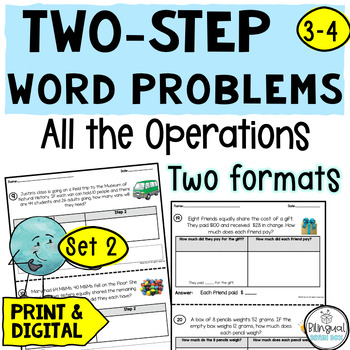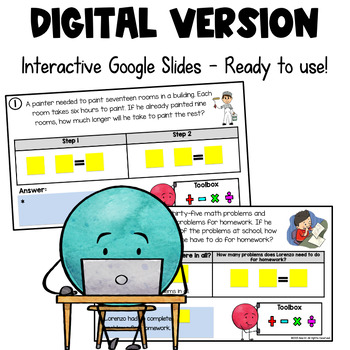Two-Step Word Problems Multiplication, Addition, Subtraction and Division
Bilingual Brain Box
3.9k Followers
Grade Levels
3rd - 4th, Homeschool
Subjects
Resource Type
Standards
CCSS3.OA.A.1
CCSS3.OA.A.2
CCSS3.OA.A.3
CCSS3.OA.D.8
Formats Included
- PDF
- Google Apps™
- Internet Activities
Pages
42 slides + Print Version
Bilingual Brain Box
3.9k Followers

Includes Google Apps™
The Teacher-Author indicated this resource includes assets from Google Workspace (e.g. docs, slides, etc.).
What educators are saying
This is a great resource to practice multi-step problem solving. Can be used in a variety of ways -independent practice, partner/group, whole group.
Great practice activities to help support my special education students continue to work on their skills.
Also included in
- This SUPER BUNDLE includes:50 word problems - Addition and Subtraction - Digital & Print50 word problems - Multiplication - Digital & Print50 word problems - Multiplication and Division - Digital & Print20 two-step word problems - All Operations with differentiated version - Digital &Price $17.25Original Price $27.65Save $10.40
Description
This resource includes 20 two-step word problems involving addition, subtraction, multiplication, and division.
It includes two formats:
Format 1: 20 two-step word problems
Format 2: 20 two-step word problems with guiding questions and sentence frames for the answers.
It includes the Google Slides™ version and the print version!
The preview video shows the digital version!
Total Pages
42 slides + Print Version
Answer Key
Included
Teaching Duration
N/A
Report this resource to TPT
Reported resources will be reviewed by our team. Report this resource to let us know if this resource violates TPT’s content guidelines.
Standards
to see state-specific standards (only available in the US).
CCSS3.OA.A.1
Interpret products of whole numbers, e.g., interpret 5 × 7 as the total number of objects in 5 groups of 7 objects each. For example, describe a context in which a total number of objects can be expressed as 5 × 7.
CCSS3.OA.A.2
Interpret whole-number quotients of whole numbers, e.g., interpret 56 ÷ 8 as the number of objects in each share when 56 objects are partitioned equally into 8 shares, or as a number of shares when 56 objects are partitioned into equal shares of 8 objects each. For example, describe a context in which a number of shares or a number of groups can be expressed as 56 ÷ 8.
CCSS3.OA.A.3
Use multiplication and division within 100 to solve word problems in situations involving equal groups, arrays, and measurement quantities, e.g., by using drawings and equations with a symbol for the unknown number to represent the problem.
CCSS3.OA.D.8
Solve two-step word problems using the four operations. Represent these problems using equations with a letter standing for the unknown quantity. Assess the reasonableness of answers using mental computation and estimation strategies including rounding.






